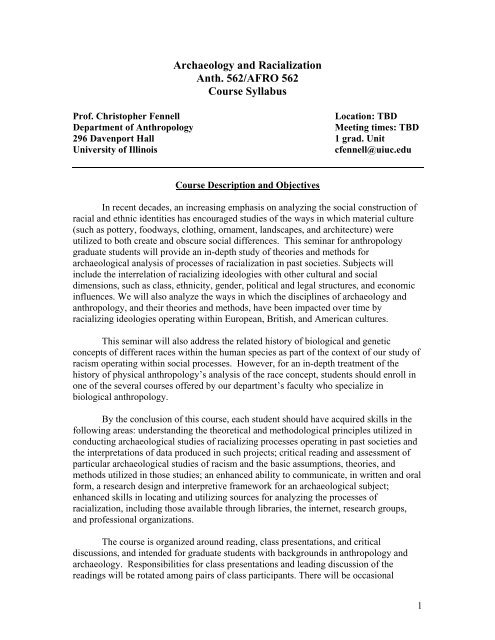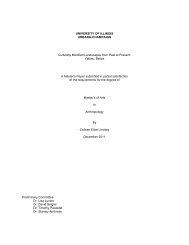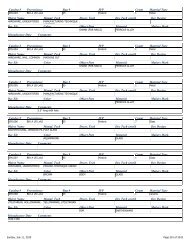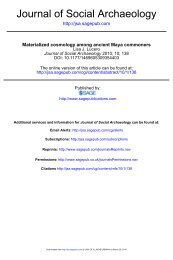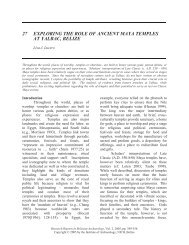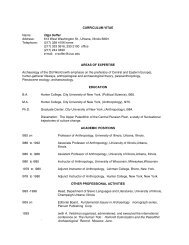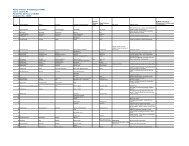Historical Archaeology - Department of Anthropology
Historical Archaeology - Department of Anthropology
Historical Archaeology - Department of Anthropology
Create successful ePaper yourself
Turn your PDF publications into a flip-book with our unique Google optimized e-Paper software.
<strong>Archaeology</strong> and RacializationAnth. 562/AFRO 562Course SyllabusPr<strong>of</strong>. Christopher FennellLocation: TBD<strong>Department</strong> <strong>of</strong> <strong>Anthropology</strong>Meeting times: TBD296 Davenport Hall 1 grad. UnitUniversity <strong>of</strong> Illinoiscfennell@uiuc.eduCourse Description and ObjectivesIn recent decades, an increasing emphasis on analyzing the social construction <strong>of</strong>racial and ethnic identities has encouraged studies <strong>of</strong> the ways in which material culture(such as pottery, foodways, clothing, ornament, landscapes, and architecture) wereutilized to both create and obscure social differences. This seminar for anthropologygraduate students will provide an in-depth study <strong>of</strong> theories and methods forarchaeological analysis <strong>of</strong> processes <strong>of</strong> racialization in past societies. Subjects willinclude the interrelation <strong>of</strong> racializing ideologies with other cultural and socialdimensions, such as class, ethnicity, gender, political and legal structures, and economicinfluences. We will also analyze the ways in which the disciplines <strong>of</strong> archaeology andanthropology, and their theories and methods, have been impacted over time byracializing ideologies operating within European, British, and American cultures.This seminar will also address the related history <strong>of</strong> biological and geneticconcepts <strong>of</strong> different races within the human species as part <strong>of</strong> the context <strong>of</strong> our study <strong>of</strong>racism operating within social processes. However, for an in-depth treatment <strong>of</strong> thehistory <strong>of</strong> physical anthropology’s analysis <strong>of</strong> the race concept, students should enroll inone <strong>of</strong> the several courses <strong>of</strong>fered by our department’s faculty who specialize inbiological anthropology.By the conclusion <strong>of</strong> this course, each student should have acquired skills in thefollowing areas: understanding the theoretical and methodological principles utilized inconducting archaeological studies <strong>of</strong> racializing processes operating in past societies andthe interpretations <strong>of</strong> data produced in such projects; critical reading and assessment <strong>of</strong>particular archaeological studies <strong>of</strong> racism and the basic assumptions, theories, andmethods utilized in those studies; an enhanced ability to communicate, in written and oralform, a research design and interpretive framework for an archaeological subject;enhanced skills in locating and utilizing sources for analyzing the processes <strong>of</strong>racialization, including those available through libraries, the internet, research groups,and pr<strong>of</strong>essional organizations.The course is organized around reading, class presentations, and criticaldiscussions, and intended for graduate students with backgrounds in anthropology andarchaeology. Responsibilities for class presentations and leading discussion <strong>of</strong> thereadings will be rotated among pairs <strong>of</strong> class participants. There will be occasional1
25 pages in length. In the seminar paper, you will explore a particular aspect <strong>of</strong>archaeology and racialization that interests you. Your paper can have a theoretical,methodological, or substantive focus. This is your opportunity to explore in greater detaila subset <strong>of</strong> the theoretical and methodological ideas encompassed by an archaeology <strong>of</strong>racialization. A revised version <strong>of</strong> your short essay should serve as the conceptualfoundation for this effort and as the introductory section <strong>of</strong> your seminar paper. Thefocus <strong>of</strong> the rest <strong>of</strong> the paper is up to you, but it needs to be cleared in advance with theinstructor. An abstract or preliminary statement, with key bibliographic references, isdue in class at the beginning <strong>of</strong> Week 9. The final seminar paper is due by 5:00pm on thefirst day <strong>of</strong> the final exam period as scheduled by the University.5. Seminar Paper Presentation and Discussion (10 percent <strong>of</strong> course grade).During the last two weeks <strong>of</strong> the course, each participant will present in class a 15-minutesynopsis <strong>of</strong> the seminar paper. This will be followed by 10-minute evaluation andcomment by a designated discussant. Following a response by the author, the floor willbe opened to general discussion. Drafts <strong>of</strong> the seminar paper will be distributed one weekbefore this presentation to all class members, including the designated discussant.When preparing these assignments, be careful that you do not plagiarize theworks <strong>of</strong> another; that is, do not present the work or words <strong>of</strong> another author in averbatim manner as your own. Consult the UIUC regulations for more information on thehazards <strong>of</strong> plagiarism, at http://www.uiuc.edu/admin_manual/code/. Assignments handedin late will lose 10% <strong>of</strong> the possible credit after the class in which they are due, and 10%more for each subsequent day late. No make-ups are provided for missed assignments inthe absence <strong>of</strong> documented and legitimate medical or family emergencies.TextsRequired Readings“Contemporary Issues Forum: Race and Racism,” American Anthropologist, guest editorFaye V. Harrison. Vol. 100, No. 3, pp. 607-715, September 1998.Skull Wars: Kennewick Man, <strong>Archaeology</strong>, and the Battle for Native American Identity,by David Hurst Thomas. New York: Basic Books, 2000.How the Irish Became White, by Noel Ignatiev. New York: Routledge, 1995.Race and Practice in Archaeological Interpretation, by Charles E. Orser, Jr.Philadelphia: University <strong>of</strong> Pennsylvania Press, 2004.Race and the <strong>Archaeology</strong> <strong>of</strong> Identity, edited by Charles E. Orser, Jr. Salt Lake City:University <strong>of</strong> Utah Press, 2001.Race and Affluence: An <strong>Archaeology</strong> <strong>of</strong> African America and Consumer Culture, by PaulR. Mullins. New York: Plenum Press, 1999.3
Additional ResourcesI have provided below, following the “Class Schedule” section <strong>of</strong> the syllabus, abibliography <strong>of</strong> additional print sources and a list <strong>of</strong> internet resources related to subjects<strong>of</strong> race and racialization. These source lists should be helpful for class participants inchoosing topics for their seminar papers and conducting research related to the course.Class ScheduleWeek 1. Course Introduction // The Race Concept in Physical <strong>Anthropology</strong>Readings will include selections from the following:(a) Templeton, Alan R. (1998). Human Races: A Genetic and Evolutionary Perspective.American Anthropologist 100(3): 632-650.(b) Cartmill, Matt (1998). The Status <strong>of</strong> the Race Concept in Physical <strong>Anthropology</strong>.American Anthropologist 100(3): 651-660.(c) American Anthropological Association Statement on Race (1998). AmericanAnthropologist 100(3): 712-713.(d) American Association <strong>of</strong> Physical Anthropologists Statement on Biological Aspects<strong>of</strong> Race (1996). American Anthropologist 100(3): 714-715.Week 2. Conflicts in the <strong>Archaeology</strong> <strong>of</strong> Past Indigenous PopulationsReadings will include selections from the following:(a) Skull Wars: Kennewick Man, <strong>Archaeology</strong>, and the Battle for Native AmericanIdentity, by David Hurst Thomas. New York: Basic Books, 2000.Chapters 1-17, on scientific racism in America, the great American skull wars, theperilous idea <strong>of</strong> race, Folsom, Clovis, and debates concerning first Americans.Week 3. Conflicts in the <strong>Archaeology</strong> <strong>of</strong> Past Indigenous Populations (cont’d)Readings will include selections from the following:(a) Skull Wars: Kennewick Man, <strong>Archaeology</strong>, and the Battle for Native AmericanIdentity, by David Hurst Thomas. New York: Basic Books, 2000.Chapters 18-24, on the non-vanishing Indian, political power gained by NativeAmericans, NAGPRA, tribal affiliations, and archaeology without alienation.Week 4. Racism among Europeans: Empirical Examples and Potential AnaloguesReadings will include selections from the following:(a) How the Irish Became White, by Noel Ignatiev. New York: Routledge, 1995.Chapters 1-6, on Irish and British politics, “white Negroes and smoked Irish,”expropriating Irish labor, political deals and racial realignments, and transformationsfrom a protestant ascendancy to a white republic.Week 5. <strong>Archaeology</strong> <strong>of</strong> Racism among European EthnicitiesReadings will include selections from the following:(a) Race and Practice in Archaeological Interpretation, by Charles E. Orser, Jr.Philadelphia: University <strong>of</strong> Pennsylvania Press, 2004.4
Chapters 1-4, on problematizing race, inventing race for archaeology, ethnicity overrace, and the challenges <strong>of</strong> archaeological interpretation.(b) Orser, Charles E., Jr. (1998). The Challenge <strong>of</strong> Race to American <strong>Historical</strong><strong>Archaeology</strong>. American Anthropologist 100(3): 661-668.Week 6. <strong>Archaeology</strong> and Racialization <strong>of</strong> the IrishDeadline: Introductory essay due.Classroom presentations on subjects <strong>of</strong> introductory essay.Readings will include selections from the following:(a) Race and Practice in Archaeological Interpretation, by Charles E. Orser, Jr.Philadelphia: University <strong>of</strong> Pennsylvania Press, 2004.Chapters 5-7, on materiality in the practice <strong>of</strong> racialization, a case study from 19thcentury Ireland, and the intersections <strong>of</strong> race, practice and archaeology.Week 7. Considerations in Constructing Predictive Frameworks andArchaeological Practice: Samples <strong>of</strong> Cultural <strong>Anthropology</strong> ApproachesReadings will include selections from the following:(a) Harrison, Faye V. (1998). Introduction: Expanding the Discourse on “Race.”American Anthropologist 100(3): 609-631.(b) Shanklin, Eugenia (1998). The Pr<strong>of</strong>ession <strong>of</strong> the Color Blind: Sociocultural<strong>Anthropology</strong> and Racism in the 21st Century. American Anthropologist 100(3): 669-679.(c) Hill, Jane N. (1998). Language, Race and White Public Space. AmericanAnthropologist 100(3): 680-689.(d) Smedley, Audrey (1998). “Race” and the Construction <strong>of</strong> Human Identity. AmericanAnthropologist 100(3): 690-702.(e) Early, Gerald (1998). Adventures in a Colored Museum: Afrocentrism, Memory, andthe Construction <strong>of</strong> Race. American Anthropologist 100(3): 703-711.Week 8. <strong>Archaeology</strong> <strong>of</strong> Constructed IdentitiesReadings will include selections from the following:(a) Orser, Charles E., Jr. (2001). Race and the <strong>Archaeology</strong> <strong>of</strong> Identity in the ModernWorld. In Race and the <strong>Archaeology</strong> <strong>of</strong> Identity, edited by Charles E. Orser, Jr., pp. 1-13.Salt Lake City: University <strong>of</strong> Utah Press.(b) Scott, Elizabeth M. (2001). “An Indolent Slothfull Set <strong>of</strong> Vagabonds”: Ethnicity andRace in a Colonial Fur-Trading Community. In Race and the <strong>Archaeology</strong> <strong>of</strong> Identity,edited by Charles E. Orser, Jr., pp. 14-33. Salt Lake City: University <strong>of</strong> Utah Press.(c) Edwards-Ingram, Ywone (2001). African American Medicine and the SocialRelations <strong>of</strong> Slavery. In Race and the <strong>Archaeology</strong> <strong>of</strong> Identity, edited by Charles E. Orser,Jr., pp. 34-53. Salt Lake City: University <strong>of</strong> Utah Press.(d) Epperson, Terrence W. (2001). “A Separate House for the Christian Slaves, One forthe Negro Slaves”: The <strong>Archaeology</strong> <strong>of</strong> Race and Identity in Late Seventeenth-CenturyVirginia. In Race and the <strong>Archaeology</strong> <strong>of</strong> Identity, edited by Charles E. Orser, Jr., pp. 54-70. Salt Lake City: University <strong>of</strong> Utah Press.5
Deadline: Draft versions <strong>of</strong> seminar papers scheduled for discussion in Week 14 are duein class at the beginning <strong>of</strong> Week 13.Readings will include selections from the following:(a) Epperson, Terrence W. (2004). Critical Race Theory and the <strong>Archaeology</strong> <strong>of</strong> theAfrican Diaspora. <strong>Historical</strong> <strong>Archaeology</strong> 38(1).(b) Epperson, Terrence W. (1999). Beyond Biological Reductionism, Ethnicity, andVulgar Anti-Essentialism: Critical Perspectives on Race and the Practice <strong>of</strong> African-American <strong>Archaeology</strong>. African-American <strong>Archaeology</strong> Newsletter No. 24, Spring 1999.(c) Franklin, Maria (1997). Why are There so Few Black American Archaeologists?Antiquity 71:799-801.(d) Franklin, Maria (1997). “Power to the People”: Sociopolitics and the <strong>Archaeology</strong> <strong>of</strong>Black Americans. <strong>Historical</strong> <strong>Archaeology</strong> 31(3): 36-50.(e) LaRoche, Cheryl, and Michael Blakey (1997). Seizing Intellectual Power. <strong>Historical</strong><strong>Archaeology</strong> 31(3): 84-106.(f) Patten, M. Drake (1997). Cheers <strong>of</strong> Protest? The Public, the Post, and the Parable <strong>of</strong>Learning. <strong>Historical</strong> <strong>Archaeology</strong> 31(3): 132-139.Week 14. Seminar Paper Presentations and WorkshopDeadline: Draft versions <strong>of</strong> seminar papers scheduled for discussion in Week 15 are duein class at the beginning <strong>of</strong> Week 14.Week 15. Seminar Paper Presentations and WorkshopDeadline: Final seminar papers due by 5:00pm on the first day <strong>of</strong> the final exam period asscheduled by the University.* * * * * *Additional SourcesRelated to <strong>Archaeology</strong> and RacializationSet forth below are nonexhaustive lists <strong>of</strong> additional sources related toarchaeological, anthropological, and historical studies <strong>of</strong> race, racism, and relatedconcepts <strong>of</strong> ethnicity and social identities.Archaeological Studies <strong>of</strong> Race Concepts and RacismArnold,. B. (1990). The Past as Propaganda: Totalitarian <strong>Archaeology</strong> in Nazi Germany.Antiquity 64: 464-78.Babson, David W. (1990). The <strong>Archaeology</strong> <strong>of</strong> Racism and Ethnicity on SouthernPlantations. <strong>Historical</strong> <strong>Archaeology</strong> 24(4): 20-28.Barile, Kerri S. (2004). Race, the National Register, and Cultural Resource Management:Creating an Historic Context for Postbellum Sites. <strong>Historical</strong> <strong>Archaeology</strong> 38(1): 90-100.7
Blakey, Michael L. (1988). Racism Through the Looking-Glass: An Afro-AmericanPerspective. World Archaeological Bulletin 2: 46-50.Blakey, Michael L. (1990). American Nationality and Ethnicity in the Depicted Past. InThe Politics <strong>of</strong> the Past, edited by Peter Gathercole and David Lowenthal, pp. 38-48.London: Unwin Hyman.Blakey, Michael L. (1995). Race, Nationalism, and the Afrocentric Past. In MakingAlternative Histories: The Practice <strong>of</strong> <strong>Archaeology</strong> in Non-Western Settings, edited byPeter R. Schmidt, pp. 213-228. Santa Fe: School <strong>of</strong> American Research Press.Blakey, Michael L. (1998). The New York African Burial Ground Project: AnExamination <strong>of</strong> Enslaved Lives, A Construction <strong>of</strong> Ancestral Ties. Transforming<strong>Anthropology</strong> 7(1): 53-58.Blakely, Robert L., and Judith M. Harrinton, editors (1998). Bones in the Basement:Postmortem Racism in Nineteenth-Century Medical Training. Washington, D.C.:Smithsonian Institution Press.Delle, James A., Stephen A. Mrozowski, and Robert Paynter, editors (2000). Lines thatDivide: <strong>Historical</strong> Archaeologies <strong>of</strong> Race, Class, and Gender. Knoxville: University <strong>of</strong>Tennessee Press.Downey, Roger (2000). Riddle <strong>of</strong> the Bones: Politics, Science, Race, and the Story <strong>of</strong>Kennewick Man. New York: Copernicus.Epperson, Terrence W. (1990) “To Fix a Perpetual Brand”: The Social Construction <strong>of</strong>Race in Virginia, 1675-1750. PhD dissertation, Temple University, Philadelphia.Epperson, Terrence W. (1990). Race and the Disciplines <strong>of</strong> the Plantation. <strong>Historical</strong><strong>Archaeology</strong> 24(4): 29-36.Epperson, Terrence W. (1994). The Politics <strong>of</strong> Empiricism and the Construction <strong>of</strong> Raceas an Analytic Category. Transforming <strong>Anthropology</strong> 5(1-2): 15-19.Epperson, Terrence W. (1996). The Politics <strong>of</strong> “Race” and Cultural Identity at theAfrican Burial Ground, New York City. World Archaeological Bulletin 7: 108-117.Epperson, Terrence W. (1999). The Contested Commons: Archaeologies <strong>of</strong> Race,Repression and Resistance in New York City. In <strong>Historical</strong> Archaeologies <strong>of</strong> Capitalism,edited by Mark Leone and Parker Potter, pp. 81-110. New York: Kluwer AcademicPress.Epperson, Terrence W. (1999). Beyond Biological Reductionism, Ethnicity, and VulgarAnti-Essentialism: Critical Perspectives on Race and the Practice <strong>of</strong> African-American<strong>Archaeology</strong>. African-American <strong>Archaeology</strong> Newsletter No. 24, Spring 1999.8
Epperson, Terrence W. (2004). Critical Race Theory and the <strong>Archaeology</strong> <strong>of</strong> the AfricanDiaspora. <strong>Historical</strong> <strong>Archaeology</strong> 38(1).Feder, Kenneth L. (1994). A Village <strong>of</strong> Outcasts: <strong>Historical</strong> <strong>Archaeology</strong> andDocumentary Research at the Lighthouse Site. Mountain View, CA: MayfieldPublishing.Franklin, Maria (1997). Why are There so Few Black American Archaeologists?Antiquity 71:799-801.Franklin, Maria (1997). “Power to the People”: Sociopolitics and the <strong>Archaeology</strong> <strong>of</strong>Black Americans. <strong>Historical</strong> <strong>Archaeology</strong> 31(3): 36-50.Franklin, Maria (2001). A Black Feminist-Inspired <strong>Archaeology</strong>? Journal <strong>of</strong> Social<strong>Archaeology</strong> 1: 108-125.Garman, James C. (1994). Viewing the Color Line Through the Material Culture <strong>of</strong>Death. <strong>Historical</strong> <strong>Archaeology</strong> 28(3):74-93.Joseph, J. W. (1993). White Columns and Black Hands: Class and Classification in thePlantation Ideology <strong>of</strong> the Georgia and South Carolina Lowcountry. <strong>Historical</strong><strong>Archaeology</strong> 27(3):57-73.LaRoche, Cheryl, and Michael Blakey (1997). Seizing Intellectual Power. <strong>Historical</strong><strong>Archaeology</strong> 31(3): 84-106.Leone, Mark P. and George C. Logan (1997). Tourism with Race in Mind: Annapolis,Maryland Examines African-American Past through Collaborative Research. In Tourismand Culture: An Applied Perspective, edited by Erve Chambers, pp. 129-146. New York:SUNY Press.Leone, Mark P., et al. (1995). Can an African-American <strong>Historical</strong> <strong>Archaeology</strong> be anAlternative Voice? In Interpreting <strong>Archaeology</strong>: Finding Meaning in the Past, edited byIan Hodder, et al., pp. 110-124. London: Routledge.Loren, Diana D. (2001). Manipulating Bodies and Emerging Traditions at the Los AdaesPresidio. In <strong>Archaeology</strong> <strong>of</strong> Traditions: Agency and History Before and After Columbus,edited by Timothy R. Pauketat, pp. 58-76. Gainesville, FL: University Press <strong>of</strong> Florida.McCann, W. J. (1994). “Volk und Germanentum”: The Presentation <strong>of</strong> the Past in NaziGermany. In The Politics <strong>of</strong> the Past, edited by Peter Gathercole and David Lowenthal,pp. 74-88. London: Unwin Hyman.9
McDavid, Carol, and David Babson, guest editors (1997). In the Realm <strong>of</strong> Politics:Prospects for Public Participation in African-American and Plantation <strong>Archaeology</strong>.<strong>Historical</strong> <strong>Archaeology</strong> 31(3): 1-152.Miller, Daniel, Michael Rowlands and Christopher Tilley, editors (1989). Dominationand Resistance. London: Routledge.Mullins, Paul (1999). Race and the Genteel Consumer: African-American Consumption,1850-1930. <strong>Historical</strong> <strong>Archaeology</strong> 33(1): 22-38.Pai, Hyung Il (2000). Constructing “Korean” Origins: A Critical Review <strong>of</strong> <strong>Archaeology</strong>,Historiography, and Racial Myth in Korean State-formation Theories. Cambridge:Harvard University Asia Center.Patten, M. Drake (1997). Cheers <strong>of</strong> Protest? The Public, the Post, and the Parable <strong>of</strong>Learning. <strong>Historical</strong> <strong>Archaeology</strong> 31(3): 132-139.Paynter, Robert, et al. (1994). The Landscapes <strong>of</strong> W.E.B. Du Bois Boyhood Homesite:An Agenda for an <strong>Archaeology</strong> <strong>of</strong> the Color Line. In Race, edited by S. Gregory and R.Sanjek, pp. 285-318. New Brunswick, N.J.: Rutgers University Press.Orser, Charles E., Jr. (1996). A <strong>Historical</strong> <strong>Archaeology</strong> <strong>of</strong> the Modern World. London:Plenum.Orser, Charles E., Jr. (1998). The <strong>Archaeology</strong> <strong>of</strong> the African Diaspora. Annual Review<strong>of</strong> <strong>Anthropology</strong> 27: 63-82.Orser, Charles E., Jr. (1999). The Challenge <strong>of</strong> Race to American <strong>Historical</strong><strong>Archaeology</strong>. American Anthropologist 100: 661-668.Otto, John S. (1980). Race and Class on Antebellum Plantations. In ArchaeologicalPerspectives on Ethnicity in America: Afro-American and Asian American CultureHistory, edited by Robert L. Schuyler, pp. 3-13. Farmingdale, N.Y.: Baywood Press.Rowlands, Michael (1989). The <strong>Archaeology</strong> <strong>of</strong> Colonialism and Constituting theAfrican Peasantry. In Domination and Resistance, edited by Daniel Miller, MichaelRowlands, and Christopher Tilley, pp. 261-283. London: Routledge.St.George, Robert Blair (1999). Placing Race at Jefferson’s Monticello. In CulturalMemory and the Construction <strong>of</strong> Identity, edited by D. Ben-Amos and L. Weissberg, pp.231-63. Wayne State University Press.Schmidt, Peter R., and Thomas C. Patterson, editors (1995). Making AlternativeHistories: The Practice <strong>of</strong> <strong>Archaeology</strong> and History in Non-Western Settings. Santa Fe,N.M.: School <strong>of</strong> American Research Press.10
Scott, Elizabeth, editor (1994). Those <strong>of</strong> Little Note: Gender, Race, and Class in<strong>Historical</strong> <strong>Archaeology</strong>. Tucson: University <strong>of</strong> Arizona Press.Shackel, Paul (2003). Memory in Black and White: Race, Commemoration, and the Post-Bellum Landscape. Walnut Creek: AltaMira.Singleton, Theresa A. (1997). Commentary: Facing the Challenges <strong>of</strong> a Public African-American <strong>Archaeology</strong>. <strong>Historical</strong> <strong>Archaeology</strong> 31(3): 146-152.Singleton, Theresa A., editor (1999). “I Too Am America”: Archaeological Studies <strong>of</strong>African-American Life. Charlottesville: University Press <strong>of</strong> Virginia.Stine, Linda F. (1990). Social Inequality and Turn-<strong>of</strong>-the-Century Farmsteads: Issues <strong>of</strong>Class, Status, Ethnicity, and Race. <strong>Historical</strong> <strong>Archaeology</strong> 24(4): 37-49.Trigger, Bruce G. (1989). A History <strong>of</strong> Archaeological Thought. New York: CambridgeUniversity Press.Watkins, Joe (2004). Becoming American or Becoming Indian? NAGPRA, Kennewickand Cultural Affiliation. Journal <strong>of</strong> Social <strong>Archaeology</strong> 4(1): 60-80.Wilkie, Laurie A. (2000). Creating Freedom: Material Culture and African AmericanIdentity at Oakley Plantation, Louisiana, 1840-1950. Baton Rouge: Louisiana StateUniversity Press.Anthropological Studies <strong>of</strong> Race Concepts and RacismArmelagos, George J., and Alan H. Goodman (1998). Race, Racism, and <strong>Anthropology</strong>.In Building a New Biocultural Synthesis: Political-Economic Perspectives in HumanBiology, edited by Alan H. Goodman and Thomas L. Leatherman, pp. 359-377. AnnArbor: University <strong>of</strong> Michigan Press.Baker, Lee D., and Thomas C. Patterson (1994). Race, Racism, and the History <strong>of</strong> U.S.<strong>Anthropology</strong>. Transforming <strong>Anthropology</strong> 5(1-2): 1-7.Baker, Lee D. (1998). From Savage to Negro: <strong>Anthropology</strong> and the Construction <strong>of</strong>Race, 1896-1954. Los Angeles: University <strong>of</strong> California Press.Bauer, J. (2000). Genealogies <strong>of</strong> Race and Culture in <strong>Anthropology</strong>: The MarginalizedEthnographers. In Race and Racism in Theory and Practice, edited by B. Lang, pp. 123-137. Lanham, MD: Rowman & Littelfield.Baumann, Gerd (1996). Contesting Cultures: Discourses <strong>of</strong> Identity in Multi-ethnicLondon. New York: Cambridge University Press.Benedict, Ruth (1940). Race: Science and Politics. New York: Viking Press.11
Benedict, Ruth (1942). Race and Racism. London: Routledge.Brace, C. Loring (1964). On the Race Concept. Current <strong>Anthropology</strong> 5(4): 313-320.Brace, C. Loring (1982). The Roots <strong>of</strong> the Race Concept in American Physical<strong>Anthropology</strong>. In A History <strong>of</strong> American Physical <strong>Anthropology</strong>, 1930-1980, edited by F.Spenser, pp. 11-29. New York: Academic Press.Brace, C. Loring (2005). “Race” is a Four-Letter Word: The Genesis <strong>of</strong> the Concept.New York: Oxford University Press.Brodkin, Karen (1998a). How Jews Became White Folks: And What That Says aboutRace in America. New Brunswick, N.J.: Rutgers University Press.Brodkin, Karen (1998b). Race, Class, and Gender: The Metaorganization <strong>of</strong> AmericanCapitalism. Transforming <strong>Anthropology</strong> 7(2): 46-57.Brown, Jacqueline N. (1998). Black Liverpool, Black America, and the Gendering <strong>of</strong>Diasporic Space. Cultural <strong>Anthropology</strong> 13(3): 291-325.Chiarelli, Bruno (1996). Race: A Fallacious Concept. International Journal <strong>of</strong><strong>Anthropology</strong> 10(2/3):97-105.Dickason, Olive P. (1976). Louisbourg and the Indians: A Study in Imperial RaceRelations, 1713-1760. Montreal: Parks Canada Press.Eichstedt, Jennifer L., and Stephen Small (2002). Representations <strong>of</strong> Slavery, Race andIdeology in Southern Plantation Museums. Washington, D.C.: Smithsonian InstitutionPress.Eller, Jack David (1999). From Culture to Ethnicity to Conflict. Ann Arbor: University <strong>of</strong>Michigan Press.Gould, Stephen Jay (1996). The Mismeasure <strong>of</strong> Man. New York: W.W. Norton.Gran, P. (1994). Race and Racism in the Modern World: How it Works in DifferentHegemonies. Transforming <strong>Anthropology</strong> 5(1-2) 8-14.Harrison, Faye V. (1995). The Persistent Power <strong>of</strong> ‘Race’ in the Cultural and PoliticalEconomy <strong>of</strong> Racism. Annual Review <strong>of</strong> <strong>Anthropology</strong> 24: 47-74.Hartigan, J., Jr. (1997a). Establishing the Fact <strong>of</strong> Whiteness. American Anthropologist99: 495-505.12
Hartigan, J., Jr. (1997b). When White Americans Are a Minority. In Cultural Diversity inthe United States, edited by L. L. Naylor, pp. 103-115. Westport, CT: Bergin & Garvey.Jablonski, Nina G. (2004). The Evolution <strong>of</strong> Human Skin and Skin Color. Annual Review<strong>of</strong> <strong>Anthropology</strong> 33: 585-623.Keita, S. O. Y., and Rick A. Kittles (1997). The Persistence <strong>of</strong> Racial Thinking and theMyth <strong>of</strong> Racial Divergence. American Anthropologist 99(3): 534-544.Livingstone, F. B. (1962). On the Non-Existence <strong>of</strong> Human Races. Current <strong>Anthropology</strong>3(3): 279-281.Marks, Jonathan (2003). “We’re Going to Tell These People Who They Really Are”:Science and Relatedness. In Relative Values: Reconfiguring Kinship Studies, edited bySarah Franklin and Susan McKinnon, pp. 355-383. Durham, N.C.: Duke UniversityPress.Mukhopadhyay, C.C. and Moses, Y.T. (1997). Reestablishing “Race” in AnthropologicalDiscourse. American Anthropologist 99: 517-533.Muldoon, J. (2000). Race or Culture: Medieval Notions <strong>of</strong> Difference. In Race andRacism in Theory and Practice, edited by B. Lang, pp. 79-97. Lanham, MD: Rowman &Littlefield.Patterson, Thomas C., and F. Spencer (1994). Racial Hierarchies and Buffer Races.Transforming <strong>Anthropology</strong> 5(1-2): 20-27.Smedley, Audrey (1999). Race in North America: Origin and Evolution <strong>of</strong> a Worldview.Boulder, CO: Westview Press, 2d ed.Stocking, George W., Jr. (1989). The Ethnographic Sensibility <strong>of</strong> the 1920s and theDualism <strong>of</strong> the Anthropological Tradition. In Romantic Motives: Essays onAnthropological Sensibility, edited by George W. Stocking, Jr., pp. 208-276.Madison,WI: University <strong>of</strong> Wisconsin Press.Stocking, George W., Jr. (1994). The Turn <strong>of</strong> the Century Concept <strong>of</strong> Race.Modernism/Modernity 1: 4-16.Trouillot, Michael R. (1995). Silencing the Past: Power and the Production <strong>of</strong> History.Boston: Beacon Press.Urciuoli, Bonnie (1996). Exposing Prejudice: Puerto Rican Experiences <strong>of</strong> Language,Race, and Class. Boulder, CO.: Westview Press.Viswewaran, Kamala (1998). Race and the Culture <strong>of</strong> <strong>Anthropology</strong>. AmericanAnthropologist 100(1): 70-83.13
Wade, Peter (1998). The Cultural Politics <strong>of</strong> Blackness in Columbia. In Blackness inLatin America and the Caribbean: Social Dynamics and Cultural Transformations,edited by Norman E. Whitten, Jr. and Arlene Torres, pp. 311-334. Bloomington, IN:Indiana University Press.Wolf, Eric R. (1994). Perilous Ideas: Race, Culture, and People. Current <strong>Anthropology</strong>35: 1-12.Wolf, Eric R. (1999). Envisioning Power: Ideologies <strong>of</strong> Dominance and Resistance.Berkeley: University <strong>of</strong> California Press.Wolf, Eric R. (2001). Pathways <strong>of</strong> Power: Building an <strong>Anthropology</strong> <strong>of</strong> the ModernWorld. Berkeley: University <strong>of</strong> California Press.<strong>Historical</strong> and Sociological Studies <strong>of</strong> Race Concepts and RacismAquirre, A., and J. Turner. (1998). American Ethnicity: The Dynamics and Consequences<strong>of</strong> Discrimination. Boston: McGraw-Hill.Allen, T. W. (1994a). The Invention <strong>of</strong> the White Race. Volume 1: Racial Opposition andSocial Control. London: Verso.Allen, T. W. (1994b). The Invention <strong>of</strong> the White Race. Volume 2: The Origin <strong>of</strong> racialOppresion in Anglo-America. London: Verso.Anderson, Benjamin (1983). Imagined Communities: Reflections on the Origin andSpread <strong>of</strong> Nationalism. London: Verso.Appiah, K. Anthony (1990). Racisms. In Anatomy <strong>of</strong> Racism, edited by David T.Goldberg, pp. 3-17. Minneapolis: University <strong>of</strong> Minnesota Press.Appiah, K. Anthony, and Amy Gutmann (1996). Color Conscious: The PoliticalMorality <strong>of</strong> Race. Princeton: Princeton University Press.Baird, Robert M. and Stuart E. Rosenbaum, editors (1993). Bigotry, Prejudice, andHatred: Definitions, Causes, and Solutions. Buffalo: Prometheus Books.Bay, Mia (2000). The White Image in The Black Mind: African-American Ideas aboutWhite People, 1830-1925. New York: Oxford University Press.Bell, Derrick (1992). Faces At The Bottom Of The Well: The Permanence Of Racism(New York: Basic Books).Bell, Derrick (1993). And We Are Not Saved: The Elusive Quest for Racial Justice. NewYork: Basic Books.14
Breen, T. H., and Stephen Innes (1980). “Myne Owne Ground”: Race and Freedom onVirginia’s Eastern Shore, 1640-1730. New York: Oxford University Press.Brown, Dee (1973). Bury My Heart at Wounded Knee. New York: Holt, Rinehart &Winston.Cadwalader, Sandra L., and Vine Deloria, Jr. (1984). The Aggressions <strong>of</strong> Civilization:Federal Indian Policy Since the 1880s. Philadelphia: Temple University Press.Carter, Stephen L. (1991). Reflections <strong>of</strong> an Affirmative Action Baby. New York: BasicBooks.Crenshaw, Kimberlé (1995). Mapping the Margins: Intersectionality, Identity Politics,and Violence Against Women <strong>of</strong> Color. In Critical Race Theory: The Key Writings ThatFormed the Movement, edited by K. Crenshaw, N. Gotanda, G. Peller, and K. Thomas,357-383. New York: New Press.Crenshaw, Kimberlé, Neil Gotanda, Gary Peller, and Kendall Thomas (1995).Introduction. In Critical Race Theory: The Key Writings That Formed the Movement,edited by K. Crenshaw, N. Gotanda, G. Peller, and K. Thomas, xiii-xxxii. New York:New Press.Curtis, L. (1996). Nothing But the Same Old Story: The Roots <strong>of</strong> Anti-Irish Racism.Belfast: Sasta Press.Curtis, L. P., Jr. (1971). Apes and Angels: The Irishman in Victorian Caricature.Washington, D.C.: Smithsonian Institution Press.D’Souza, D. (1995). The End <strong>of</strong> Racism: Principles for a Multiracial Society. New York:Free Press.Dalton, Harlon L. (1995). Racial Healing: Confronting the Fear Between Blacks andWhites. New York: Doubleday.Delgado, Richard, and Jean Stefanic (1993). Critical Race Theory: An AnnotatedBibliography. Virginia Law Review 79:461-516.DeLoria, Vine, Jr. (1988). Custer Died for Your Sins: An Indian Manifesto. Norman:University <strong>of</strong> Oklahoma Press.DeLoria, Vine, Jr. (1995). Red Earth, White Lies: Native Americans and the Myth <strong>of</strong>Scientific Fact. New York: Scribner.Drinnon, Richard (1980). Facing West: The Metaphysics <strong>of</strong> Indian-Hating and Empire-Building. New York: New American Library.15
Du Bois, W. E. B. (1920). Darkwater: Voices from Within the Veil. New York: HarcourtBrace.Du Bois, W. E. B. (1939). Black Folk, Then and Now: An Essay in the History andSociology <strong>of</strong> the Negro Race. New York: Henry Holt.Du Bois, W. E. B. (1984). Dusk to Dawn: An Essay Toward an Autobiography <strong>of</strong> a RaceConcept. New Brunswick, N.J.: Transaction Press.Dudley, William, editor (1991). Racism in America: Opposing Viewpoints. San Diego,CA.: Greenhaven Press.Early, Gerald, editor (1993). Lure and Loathing: Essays on Race, Identity, and theAmbivalence <strong>of</strong> Assimilation. New York: Penguin Press.Fanon, Frantz (1968a). The Wretched <strong>of</strong> the Earth, translated by C. Farrington NewYork: Grove Press.Fanon, Frantz (1968b). Black Skin, White Masks, translated by Charles L. Markmann.New York: Grove Press.Fields, B. J. (1982). Ideology and Race in American History. In Region, Race, andReconstruction: Essays in Honor <strong>of</strong> C. Vann Woodward, edited by J. M. Kousser and J.M. McPherson, pp. 143-177. New York: Oxford University Press.Fields, B. J. (1990). Slavery, Race, and Ideology in the United States <strong>of</strong> America. NewLeft Review 181: 95-118.Frankenberg, Ruth (1993). Race Matters: The Social Construction <strong>of</strong> Whiteness.Minneapolis: University <strong>of</strong> Minnesota Press.Gilroy, Paul (1993). The Black Atlantic: Modernity and Double-Consciousness.Cambridge, MA: Harvard University Press.Goldberg, David T. (1993). Racist Culture: Philosophy and the Politics <strong>of</strong> Meaning.Oxford: Blackwell.Goldberg, David T., editor (1990). Anatomy <strong>of</strong> Racism. Minneapolis: University <strong>of</strong>Minnesota Press.Gossett, Thomas (1963). Race: the History <strong>of</strong> an Idea in America. Dallas: SouthernMethodist University.Gubar, Susan (1997). White Skin, Black Face in American Culture. New York: OxfordUniversity Press.16
Guglielmo, Jennifer, and Salvatore Salerno, editors (2003). Are Italians White?: HowRace is Made in America. New York: Routledge.Halter, Marilyn (1993). Between Race and Ethnicity: Cape Verdean AmericanImmigrants, 1860-1965. Chicago: University <strong>of</strong> Illinois Press.Haney López, Ian F. (1994). The Social Construction <strong>of</strong> Race: Some Observations onIllusion, Fabrication, and Choice. Harvard Civil Rights/Civil Liberties Law Review 29:1-62.Haney López, Ian F. (1995). The Social Construction <strong>of</strong> Race. In Critical Race Theory:The Cutting Edge, edited by R. Delgado, pp. 191-203. Philadelphia: Temple UniversityPress.Haney López, Ian F. (1996). White By Law: The Legal Construction <strong>of</strong> Race. New York:New York University Press.Hobsbawn, Eric J., and Terence D. Ranger, editors (1983). The Invention <strong>of</strong> Tradition.New York: Cambridge University Press.Jacobson, Matthew Frye (1998). Whiteness <strong>of</strong> a Different Color: European Immigrantsand the Alchemy <strong>of</strong> Race. Cambridge, MA: Harvard University Press.Jaimes, M. Annette (1992). The State <strong>of</strong> Native America: Genocide, Colonization, andResistance. Boston: South End Press.Jordan, Winthrop D. (1968). White over Black: American Attitudes toward the Negro1550-1812. Chapel Hill: University <strong>of</strong> North Carolina Press.Kitano, Harry (1997). Race Relations. Englewood Cliffs, NJ: Prentice-Hall.Kivel, Paul (1996). Uprooting Racism: How White People Can Work for Racial Justice.Gabriola Island, BC: New Society Publishers.MacFarquhar, Larissa (1996). The Color <strong>of</strong> Law. Lingua Franca July/August 1996, 40-47.McDonnell, Janet (1991). The Dispossession <strong>of</strong> the American Indian. Bloomington:Indiana University Press.Marable, Manning (1995). Beyond Black and White: Transforming African-AmericanPolitics. New York: Verso.Monk, Richard C., editor (1994). Taking Sides: Race and Ethnicity. Guilford, CN:Dushkin Publishing Group.17
Morgan, Edmund S. (1975). American Slavery, American Freedom: The Ordeal <strong>of</strong>Colonial Virginia. New York: W. W. Norton.Mullings, Leith (1997). On Our Own Terms: Race, Class, and Gender in the Lives <strong>of</strong>African American Women. New York: Routledge.Omi, Michael, and Howard Winant (1986). Racial Formation in the United States: Fromthe 1960s to the 1980s. London: Routledge.Parker, Linda (1989). Native American Estate: The Struggle Over Indian and HawaiianLands. Honolulu: University <strong>of</strong> Hawaii Press.Parrillo, Vincent N. (2004). Understanding Race and Ethnic Relations. New York: Allyn& Bacon, 2d edition.Poignant, Roslyn (2004). Pr<strong>of</strong>essional Savages: Captive Lives and Western Spectacle.New Haven: Yale University Press.“Race and Racism,” Salmagundi, Nos. 104-105 (Fall, 1994-Winter, 1995), pp. 3-155.Roberts, Diane (1994). The Myth <strong>of</strong> Aunt Jemima: Representations <strong>of</strong> Race and Region.New York: Routledege.Roediger, David R. (1994). Towards the Abolition <strong>of</strong> Whiteness: Essays on Race,Politics, and Working Class History. London: Verso.Rosenblum, Karen E., and Toni-Michelle C. Travis (2002). The Meaning <strong>of</strong> Difference:American Constructions <strong>of</strong> Race, Sex and Gender, Social Class, and Sexual Orientation.New York: McGraw-Hill.Rothenberg, Paula S., editor (1995). Race, Class, and Gender in the United States. NewYork: St. Martin’s Press, 3d ed.Said, Edward (1994). Culture and Imperialism. New York: Vintage Books.Sanjek, Roger (2000). The Future <strong>of</strong> Us All: Race and Neighborhood Politics in NewYork City. Ithaca: Cornell University Press.Shepherd, George, and David Penna. (1991). Racism and the Underclass: State Policyand Discrimination Against Minorities. Westport, CT: Greenwood Press.Stanton, William (1960). The Leopard’s Spots: Scientific Attitudes toward Race inAmerica: 1815-1859. Chicago: University <strong>of</strong> Chicago Press.18
Steele, Shelby (1990). The Content <strong>of</strong> Our Character: A New Vision <strong>of</strong> Race in America.New York: Harper Collins.Susser, Ida and Thomas Patterson, editors (2001). Cultural Diversity in the UnitedStates. London: Blackwell Publishers.Vaughan, A. T., editor (1995). Roots <strong>of</strong> American Racism: Essays on the ColonialExperience. New York: Oxford University Press.West, Cornel (1993a). Race Matters. Boston: Beacon Press.West, Cornel (1993b). Prophetic Thought in Postmodern Times. Monroe, Maine:Common Courage Press.Williams, Patricia J. (1991). The Alchemy <strong>of</strong> Race and Rights. Cambridge: HarvardUniversity Press.Winant, Howard (2000). Race and Race Theory. Annual Review <strong>of</strong> Sociology 26: 169-185.Wright, B., and W. Tierney. (1991). American Indians in Higher Education: A History <strong>of</strong>Culture Conflict. Change Magazine 23:11-18.Yetman, Norman, and C. Hoy Steele, editors (1975). Majority and Minority. Boston:Allyn & Bacon.Zack, Naomi (1993). Race and Mixed Race. Philadelphia: Temple University Press.Studies <strong>of</strong> Ethnicity and Social IdentityAppiah, K. Anthony (1994). Identity, Authenticity, Survival: Multicultural Societies andSocial Reproduction. In Multiculturalism, edited by Amy Gutman, pp. 149-163.Princeton, NJ: Princeton University Press.Balibar, Etienne, and Immanuel Wallerstein, editors (1991). Race, Nation, Class:Ambiguous Identities. London: Verso.Banks, Marcus (1996). Ethnicity: Anthropological Constructions. London: Routledge.Barford, P., et al. (1991). Between the Slavs, Balts, and Germans: Ethnic Problems in the<strong>Archaeology</strong> and History <strong>of</strong> Podlasie. Archaeologia Polona 29: 123-60.Barth, Fredrik (1998a). Introduction. In Ethnic Groups and Boundaries: The SocialOrganization <strong>of</strong> Culture Difference, edited by Fredrik Barth, pp. 9-38. Prospect Heights,Illinois: Waveland Press.19
Barth, Fredrik (1998b). Pathan Identity and Its Maintenance. In Ethnic Groups andBoundaries: The Social Organization <strong>of</strong> Culture Difference, edited by Fredrik Barth, pp.117-134. Prospect Heights, Illinois: Waveland Press.Barth, Fredrik (2000). Boundaries and Connections. In Signifying Identities:Anthropological Perspectives on Boundaries and Contested Values, edited by Andrew P.Cohen, pp. 15-36. London: Routledge.Bentley, G. Carter (1987). Ethnicity and Practice. Comparative Studies in Society andHistory 29(1): 24-55.Berlin, Ira (1996). From Creole to African: Atlantic Creoles and the origins <strong>of</strong> African-American society in mainland North America. William & Mary Quarterly (3d series)53(2): 251-288.Blakey, Michael L. (1990). American Nationality and Ethnicity in the Depicted Past. InThe Politics <strong>of</strong> the Past, edited by Peter Gathercole and David Lowenthal, pp. 38-48.London: Unwin Hyman.Brown, L. K., and K. Mussell, editors (1984). Ethnic and Regional Foodways in theUnited States: The Performance <strong>of</strong> Group Identity. Knoxville: University <strong>of</strong> TennesseePress.Brumfiel, Elizabeth M. (1994). Ethnic Groups and Political Development in AncientMexico. In Factional Competition and Political Development in the New World, editedby Elizabeth M. Brumfiel and John W. Fox, pp. 89-102. Cambridge: CambridgeUniversity Press.Bruner, Edward M. (1993). Epilogue: Creative Persona and the Problem <strong>of</strong> Authenticity.In Creativity/<strong>Anthropology</strong>, edited by Lavie, S., Narayan, K., and Rosaldo, R., pp. 321-334. Ithaca: Cornell University Press.Burke, Heather (1999). Meaning and Ideology in <strong>Historical</strong> <strong>Archaeology</strong>: Style, SocialIdentity, and Capitalism in an Australian Town. New York: Kluwer Academic andPlenum Publishers.Clifford, James (1994). Diasporas. Cultural <strong>Anthropology</strong> 9(3): 302-338.Cohen, Andrew P., editor (2000). Signifying Identities: Anthropological Perspectives onBoundaries and Contested Values. London: Routledge.Cox, O. C. (1948). Caste, Class, and Race: A Study in Social Dynamics. New York:Doubleday.Csikszentmihalyi, Mihaly, and Eugene Rochberg-Halton (1981). The Meanings <strong>of</strong>Things: Domestic Symbols and the Self. Cambridge: Cambridge University Press.20
De Vos, George (1975). Ethnic Pluralism: Conflict and Accommodation. In EthnicIdentity: Cultural Continuities and Change, edited by George De Vos and LolaRomanucci-Ross, pp. 5-41. Palo Alto, California: Mayfield Publishing.Dietler, Michael (1994). “Our Ancestors the Gauls”: <strong>Archaeology</strong>, Ethnic Nationalism,and the Manipulation <strong>of</strong> Celtic Identity in Modern Europe. American Anthropologist 96:584-605.Dietler, Michael, and Ingrid Herbich (1998). Habitus, Techniques, Style: An IntegratedApproach to the Social Understanding <strong>of</strong> Material Culture and Boundaries. In The<strong>Archaeology</strong> <strong>of</strong> Social Boundaries, edited by Miriam T. Stark, pp. 232-263. Washington,D.C.: Smithsonian Institution Press.Dongoske, K. E., et al. (1997). Archaeological Cultures and Cultural Affiliation: Hopiand Zuni Perspectives in the American Southwest. American Antiquity 62: 600-608.Emberling, Ge<strong>of</strong>f (1997). Ethnicity in Complex Societies: Archaeological Perspectives.Journal <strong>of</strong> Archaeological Research 5(4): 295-344.Eriksen, Thomas (2002). Ethnicity and Nationalism: Anthropological Perspectives.London: Pluto.Fennell, Christopher C. (2000). Conjuring Boundaries: Inferring Past Identities fromReligious Artifacts. International Journal <strong>of</strong> <strong>Historical</strong> <strong>Archaeology</strong> 4(4): 281-313.Fennell, Christopher C. (2003). Group Identity, Individual Creativity and SymbolicGeneration in a BaKongo Diaspora. International Journal <strong>of</strong> <strong>Historical</strong> <strong>Archaeology</strong>7(1):1-31.Ferguson, Leland G. (1992). Uncommon Ground: <strong>Archaeology</strong> and Early AfricanAmerica. Washington, D.C.: Smithsonian Institution Press.Franklin, Maria, and Garrett Fesler (1999). The Exploration <strong>of</strong> Ethnicity and the<strong>Historical</strong> Archaeological Record. In <strong>Historical</strong> <strong>Archaeology</strong>, Identity Formation, andthe Interpretation <strong>of</strong> Ethnicity, edited by Maria Franklin and Garrett Fesler, pp. 1-10.Williamsburg, Virginia: Colonial Williamsburg Foundation.Friedman, Jonathan (1989). Culture, Identity and World Process. In Domination andResistance, edited by Daniel Miller, Michael Rowlands, and Christopher Tilley, pp. 246-260. London: Routledge.Friedman, Jonathan (1992). The Past in the Future: History and the Politics <strong>of</strong> Identity.94(4) American Anthropologist 837-59.21
Gomez, Michael A. (1998). Exchanging Our Country Marks: The Transformation <strong>of</strong>African Identities in the Colonial and Antebellum South. Chapel Hill, North Carolina:University <strong>of</strong> North Carolina Press.Guidieri, Remo, Francesco Pellizi, and Stanley Tambiah, editors (1988). Ethnicities andNations: Processes <strong>of</strong> Interethnic Relations in Latin America, Southeast Asia, and thePacific. Austin: University <strong>of</strong> Texas Press.Gundaker, Grey (1998). Signs <strong>of</strong> Diaspora, Diaspora <strong>of</strong> Signs: Literacies, Creolization,and Vernacular Practices in African America. New York: Oxford University Press.Gundaker, Grey (2000). Creolization, Complexity and Time. <strong>Historical</strong> <strong>Archaeology</strong>34(3): 124-133.Handler, Richard (1994). Is “Identity” a Useful Cross-cultural Concept? InCommemorations: The Politics <strong>of</strong> National Identity, edited by J. R. Gillis, pp. 27-40.Princeton, New Jersey: Princeton University Press.Hodder, Ian (2000). Agency and Individuals in Long-Term Processes. In Agency in<strong>Archaeology</strong>, edited by Marcia-Anne Dobres and John E. Robb, pp. 21-33. London:Routledge.Holland, Dorothy, William Lachicotte, Debra Skinner, and Carole Cain (2001). Identityand Agency in Cultural Worlds. Cambridge: Harvard University Press.Horning, Audrey J. (1999). In Search <strong>of</strong> “Hollow Ethnicity:” ArchaeologicalExplorations <strong>of</strong> Rural Mountain Settlement. In <strong>Historical</strong> <strong>Archaeology</strong>, IdentityFormation, and the Interpretation <strong>of</strong> Ethnicity, edited by Maria Franklin and GarrettFesler, pp. 121-137. Williamsburg, Virginia: Colonial Williamsburg Foundation.Howson, Jean E. (1990). Social Relations and Material Culture: A Critique <strong>of</strong> the<strong>Archaeology</strong> <strong>of</strong> Plantation Slavery. <strong>Historical</strong> <strong>Archaeology</strong> 24(4): 78-91.Hutchinson, John, and Anthony Smith, editors (1996). Ethnicity. New York: OxfordUniversity Press.Jones, Sian (1997). The <strong>Archaeology</strong> <strong>of</strong> Ethnicity: Constructing Identities in the Past andthe Present. London: Routledge.Jones, Sian (1999). <strong>Historical</strong> Categories and the Praxis <strong>of</strong> Idetity: The Interpretation <strong>of</strong>Ethnicity in <strong>Historical</strong> <strong>Archaeology</strong>. In <strong>Historical</strong> <strong>Archaeology</strong>: Back from the Edge,edited by Pedro P. A. Funari, Martin hall, and Sian Jones, pp. 219-232. London:Routledge.22
Kelly, Marsha C., and Roger E. Kelly (1980). Approaches to Ethnic Identification in<strong>Historical</strong> <strong>Archaeology</strong>. In Archaeological Perspectives on Ethnicity in America, editedby Robert L. Schuyler, pp. 133-144. Farmingdale, New York: Baywood Publishing Co.Lash, Scott, and Jonathan Friedman, editors (1992). Modernity and Identity. Oxford:Blackwell.McGuire, Randall H. (1982). The Study <strong>of</strong> Ethnicity in <strong>Historical</strong> <strong>Archaeology</strong>. Journal<strong>of</strong> Anthropological <strong>Archaeology</strong> 1:159-178.Mintz, Sidney W. and Richard Price (1976). An Anthropological Approach to the Afro-American Past: A Caribbean Perspective. ISHI Occasional Papers in Social Change,Volume 2. Philadelphia: Institute for the Study <strong>of</strong> Human Issues.Morgan, Philip D. (1998). Slave Counterpoint: Black Culture in the Eighteenth-CenturyChesapeake & Lowcountry. Chapel Hill: University <strong>of</strong> North Carolina Press.Morris, Brian (1994). <strong>Anthropology</strong> <strong>of</strong> the Self: The Individual in Cultural Perspective.London: Pluto Press.Orser, Charles E., Jr. (1991). The Archaeological Search for Ethnicity in the HistoricUnited States. Archaeologia Polona 29: 109-121.Palmer, Colin A. (1995). From Africa to the Americas: Ethnicity in the Early BlackCommunities <strong>of</strong> the Americas. Journal <strong>of</strong> World History 6(2): 223-236.Perry, Warren and Robert Paynter (1999). Artifacts, Ethnicity, and the <strong>Archaeology</strong> <strong>of</strong>African Americans. In “I, Too, Am America:” Archaeological Studies <strong>of</strong> African-American Life, edited by Theresa A. Singleton, pp. 299-310. Charlottesville, Virginia:University Press <strong>of</strong> Virginia.Pollard, Helen P. (1994). Ethnicity and Political Control in a Complex Society: theTarascan State <strong>of</strong> PreHispanic Mexico. In Factional Competition and PoliticalDevelopment in the New World, edited by Elizabeth M. Brumfiel and John W. Fox, pp.79-88. Cambridge: Cambridge University Press.Praetzellis, Adrian, Mary Praetzellis and Marley Brown III (1987). Artifacts as Symbols<strong>of</strong> Identity: An Example from Sacramento’s Gold Rush Era Chinese Community. InLiving in Cities: Current Research in Urban <strong>Archaeology</strong>, edited by Edward Staski, pp.38-47. Ann Arbor, Michigan: Society for <strong>Historical</strong> <strong>Archaeology</strong>.Romanucci-Ross, Lola, and George DeVos, editors (1995). Ethnic Identity: Creation,Conflict, Accommodation. Walnut Creek, CA: Altimira Press.Sackett, James R. (1985). Style and Ethnicity in the Kalahari: A Reply to Wiessner.American Antiquity 50(1): 154-159.23
Samford, Patricia (1996). The <strong>Archaeology</strong> <strong>of</strong> African-American Slavery and MaterialCulture. William and Mary Quarterly (3d series) 53(1): 87-114.Shennan, Stephen J., editor (1989). Archaeological Approaches to Cultural Identity.London: Unwin Hyman.Singleton, Theresa A. and Mark D. Bograd (1995). The <strong>Archaeology</strong> <strong>of</strong> the AfricanDiaspora in the Americas. Guides to the Archaeological Literature <strong>of</strong> the ImmigrantExperience in America, No. 2. Tucson, Arizona: Society for <strong>Historical</strong> <strong>Archaeology</strong>.Spicer, Edward H. (1971). Persistent Cultural Systems. Science 174: 795-800.Sobel, Mechal (1987). The World They Made Together: Black and White Values inEighteenth-Century Virginia. Princeton, New Jersey: Princeton University Press.Staski, Edward (1990). Studies in Ethnicity in North American <strong>Historical</strong> <strong>Archaeology</strong>.North American Archaeologist 11(2): 121-145.Sterner, Judy (1989). Who is Signalling Whom? Ceramic Style, Ethnicity andTaphonomy among the Sirak Bulahay. Antiquity 63: 451-459.Stewart-Abernathy, Leslie C., and B. L. Ruff (1989). A Good Man in Israel:Zooarchaeology and Assimilation in Antebellum Washington, Arkansas. <strong>Historical</strong><strong>Archaeology</strong> 23(2): 96-112.Stuckey, Sterling (1987). Slave Culture: Nationalist Theory and the Foundations <strong>of</strong> BlackAmerica. New York: Oxford University Press.Taylor, Charles (1994). The Politics <strong>of</strong> Recognition. In Multiculturalism, edited by AmyGutman, pp. 25-73. Princeton, NJ: Princeton University Press.Vermeulen, Hans, and Cora Govers, editors (1996). The <strong>Anthropology</strong> <strong>of</strong> Ethnicity:Beyond “Ethnic Groups and Boundaries”. Amsterdam: Het Spinhuis.Wiessner, Polly (1983). Style and Social Information in Kalahari San Projectile Points.American Antiquity 48(2): 253-276.Wiessner, Polly (1989). Style and Changing Relations Between the Individual andSociety. In The Meaning <strong>of</strong> Things: Material Culture and Symbolic Expression, edited byIan Hodder, pp. 56-63. London: Unwin Hyman.Wilkie, Laurie A. (2000). Creating Freedom: Material Culture and African AmericanIdentity at Oakley Plantation, Louisiana, 1840-1950. Baton Rouge: Louisiana StateUniversity Press.24
Matters <strong>of</strong> Race (PBS):http://www.pbs.org/matters<strong>of</strong>race/Race: The Power <strong>of</strong> an Illusion (PBS):http://www.pbs.org/raceSociety for American <strong>Archaeology</strong>, Repatriation Issues:http://www.saa.org/goverment/index.htmlWho Owns the Past? (PBS):http://www.pbs.org/wotp/World Conference Against Racism:http://www.un.org/WCAR/index.html26


